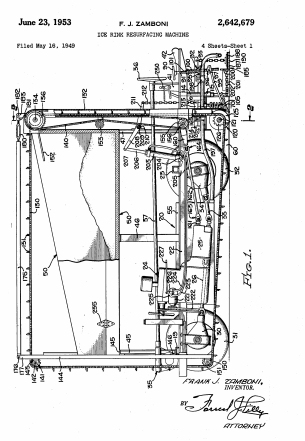When you think of famous patents and inventions, you probably first think of patents like Alexander Graham Bell’s telephone (U.S patent number 174,465) or Thomas Edison’s version of the light bulb (U.S patent number 223,898). But, the truth is that in any given moment, you’re surrounded by an endless number of patented inventions that have improved our lives. The world of sports is no different, with everything from player gear to equipment constantly being updated and patented.
In the United States, we love our sports, with just under 60% of Americans professing themselves to be sports fans according to a 2015 Gallup poll1. Most of those polled prefered the classic football, followed by baseball and soccer, but hockey2 — long a beloved sport in the upper midwest — is gradually becoming a favorite sport all across the country.
Hockey has a long and winding history. While the first real organized game was played in 1875, its beginnings date back even further than that, with various elements of other sports, like field hockey and a Gaelic game known as hurling, playing roles in creating the hockey that we know today.
As we inch further into the Stanley Cup playoffs, let’s take a look at some of the patents that have made and continue to make this growing sport the transformative and exciting game that it is today.
The Equipment: From Hockey Sticks to Hockey Pucks
Originally, hockey sticks were single pieces carved individually out of wood. In 1924, Canadian Zachariah Adam Hall filed a patent3 to make hockey sticks easy and inexpensive to mass produce, as well as to improve upon the “strength and balance” of hockey playing by using a stick made of two pieces. He later filed additional patents in an attempt to improve on the stick design, namely to make it more lightweight.
This desire for a lightweight and sturdy stick continued through the decades, and continues to this day, with the material of hockey sticks and blades changing from wood to ash, fiberglass, aluminum, and finally to today’s composite materials, all with a slew of patents following suit. Safeguards, like a 1958 patent application filed by Harry Doughty, also gained use, as hockey was known for being a rather violent sport in those early days. Of course, the stick is now famously curved, as well.

Zachariah Adam Hall’s 1920s hockey stick design.

The hockey stick safety butt by Harry Doughty
What about hockey pucks? In 1940, inventor Arthur Ross revolutionized the game by filing an application for a new, patented design4 that sought to eliminate the sharp edges and rolling tendency of the pucks currently in use, eliminating more of the danger involved in hockey play and offering players more control over the puck.

The hockey puck by Arthur Ross.
The Gear: Helmets and Skates
For decades, hockey players didn’t wear helmets, and any padding they eventually wore wasn’t considered durable or able to provide much protection. The lack of helmets or quality safety gear resulted in countless injuries for players. In 1923, Hart Henry Ridgeway filed a patent5 for the invention of protective athletic gear using sponge rubber as opposed to the more common felt, while in 1960, Luther D. Howard filed an original patent design6 for a universal, easily adjustable helmet.
The helmet slowly grew as an accepted part of ice hockey practice, before becoming a requirement for future players of the National Hockey League at the end of the 1970s. There were numerous patents improving on ice hockey helmet design in the following years, such as William H. Carveth’s 1993 patent7 for a helmet meant to protect the neck. Today, helmets continue to evolve with new technologies, such as energy or impact absorbing inventions, leading to still more patents.

Luther D. Howard’s adjustable helmet.
Skating, itself, is actually an ancient form of travel. As time went on, skating was found to be enjoyable simply as a recreational activity, and skating soon found its way into a variety of sports, including ice hockey.
Thanks to patents, such as this one filed by Robert Bustin8 in 1901 that included a runner and a metal footplate, we aren’t skating around with the use of animal bone like in the old days. Skating continues to improve with the rest of ice hockey’s innovations. In fact, inventor David Blois filed a patent in 20139 for improvements on his new ice skate suspension system, which uses a spring for optimal skating power.

Robert Bustin’s 1901 skate design.
The Ice
When it comes to the rinks themselves, patents filed for artificial skating rinks date back as far as the 1800s. In 1891, Ira H. Jewell and William H. Jewell filed a patent for an all-season artificial ice skating rink in which they planned to freeze water or another liquid to use as the ice. Their reasoning for creating an artificial rink during a time when roller skating had become popular? They felt that breathing in the cool air would be healthier.

A plan for an artificial ice skating rink patented in 1891.
Ice skating rinks were in full force in the 1940s, just in time for Frank Zamboni to begin developing his idea for an ice resurfacing machine, a patent he first filed as early as 1949. The rest, as they say, is ice hockey history.

One of the first drawings of the Zamboni machine, still in use today.
Ready to Protect Your Own Intellectual Property?
Do you have the next great invention? Or, maybe you want to learn more about how to protect your intellectual property? Contact the team at Garcia-Zamor today to access our essential legal services regarding your patent, copyright, trademark, and related intellectual property needs.
Resources
1As Industry Grows, Percentage of U.S. Sports Fans Steady – Gallup – https://news.gallup.com/poll/183689/industry-grows-percentage-sports-fans-steady.aspx
2Ice Hockey – Encyclopedia Brittanica – https://www.britannica.com/sports/ice-hockey
3Hockey Stick Patent – US Patent 1,549,971
4Roll-Preventing Hockey Puck – US Patent 2,226,516
5Protective Device for Athletic Wear – US Patent 1,594,174
6Protective Hockey Helmet (1960) – US Patent 3,087,166
7Protective Hockey Helmet (1993) – US Patent 5,553,330
8Ice Skate Patent – US Patent 689,851
9Skate Suspension System and Method of Assembly – US Patent Publication 2013/0285338







